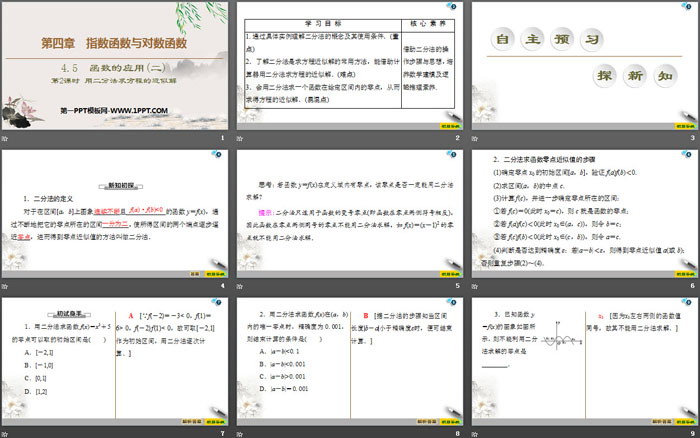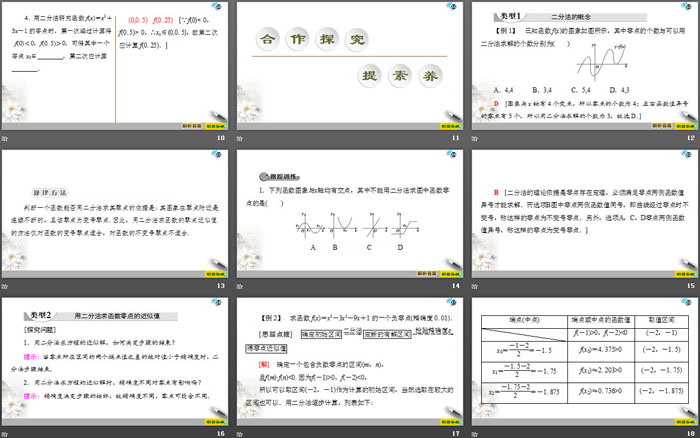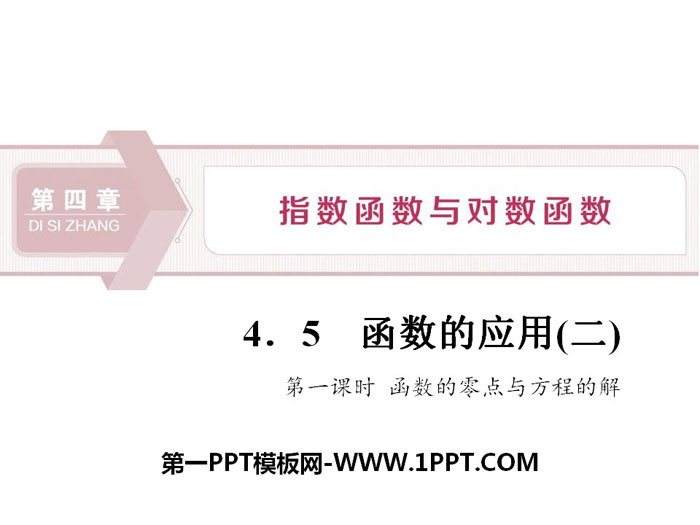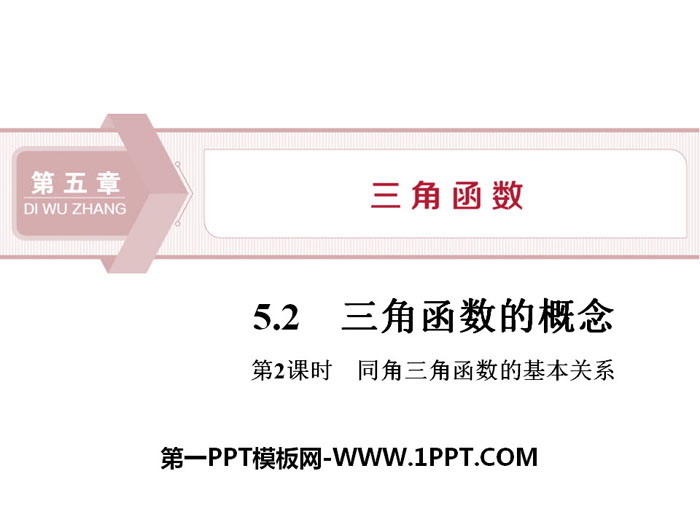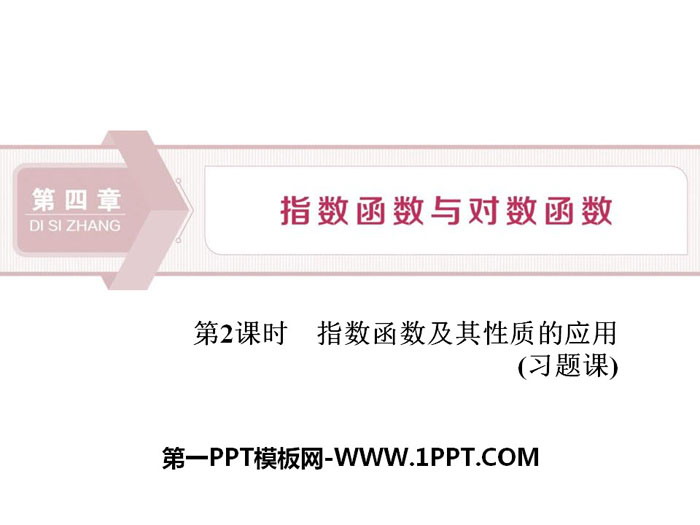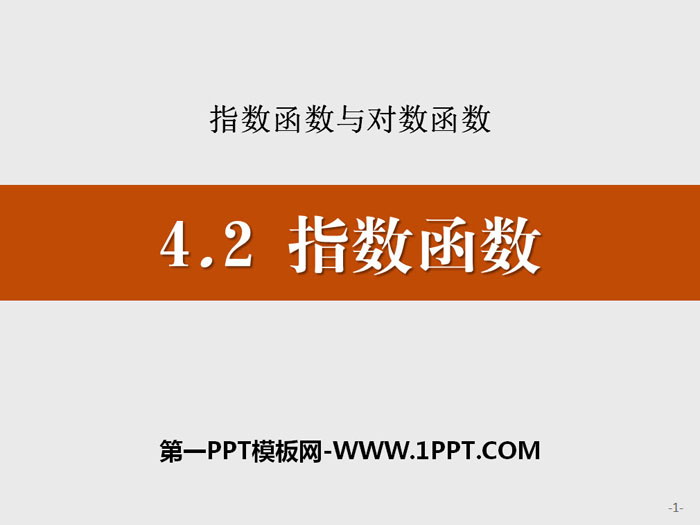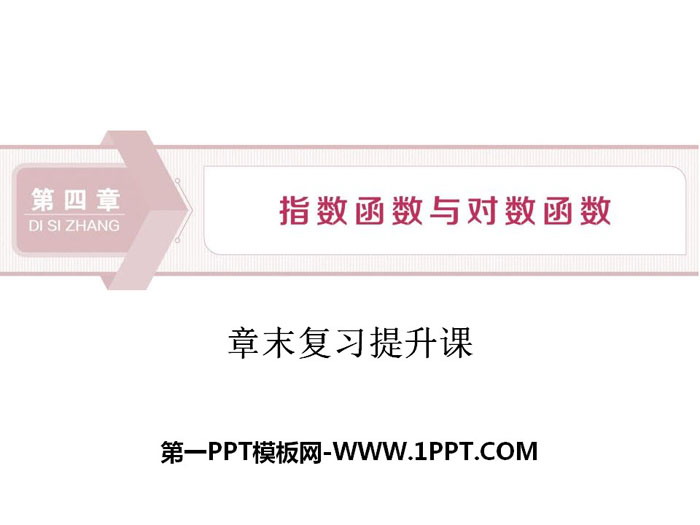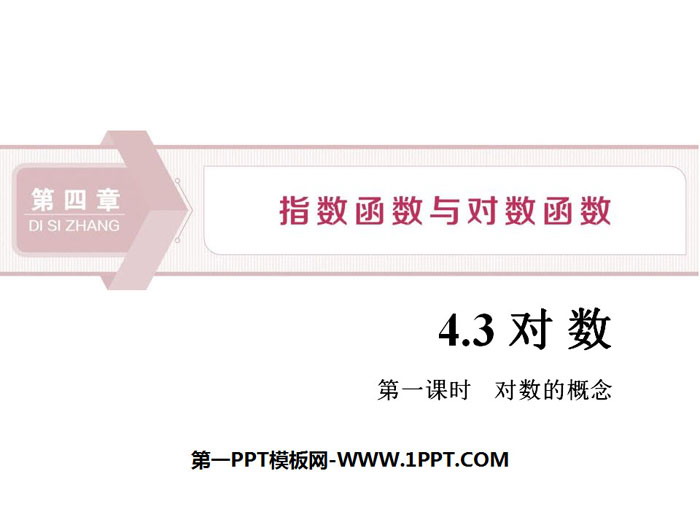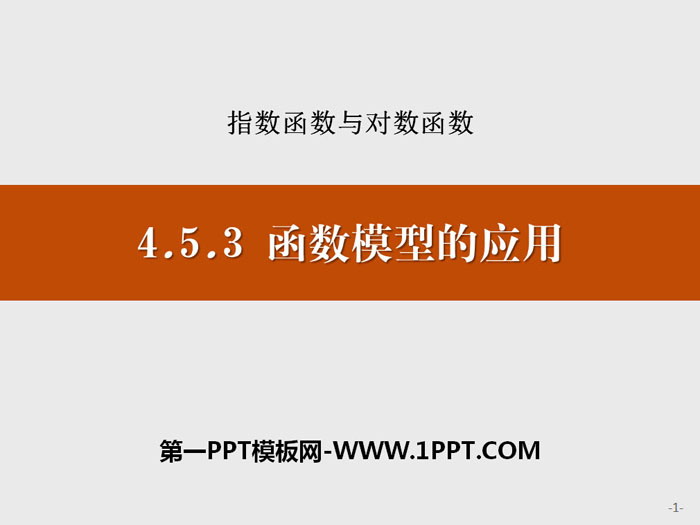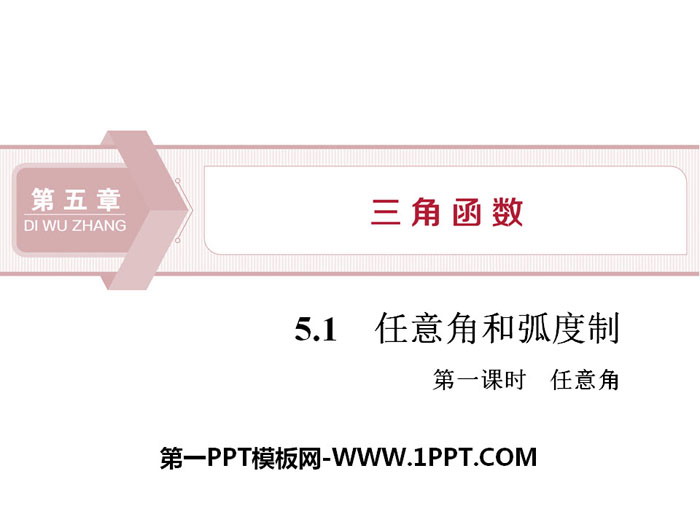
| Category | Format | Size |
|---|---|---|
| People's Education High School Mathematics Edition A Compulsory Course 1 | pptx | 6 MB |
Description
"Applications of Functions" Exponential Functions and Logarithmic Functions PPT Courseware (Using the Dichotomy Method to Find Approximate Solutions to Equations in Lesson 2)
Part One: Learning Objectives
1. Understand the concept of dichotomy and the conditions for its use through specific examples. (emphasis)
2. Understand that the bisection method is a common method for finding approximate solutions to equations, and be able to use the bisection method to find approximate solutions to equations with the help of a calculator. (difficulty)
3. Can use the bisection method to find the zero point of a function in a given interval, thereby obtaining an approximate solution to the equation. (easy to mix)
core competencies
With the help of the operating steps and ideas of the dichotomy method, cultivate mathematical modeling and logical reasoning literacy.
Application of functions PPT, part 2: independent preview and exploration of new knowledge
1. dichotomy definition
For the function y=f(x) of the graph __________ and __________ on the interval [a,b], by continuously changing the interval where its zero point is located to __________, the two obtained intervals are The method in which the endpoints gradually approach _________ and then obtain the zero-point approximation is called the bisection method.
Thinking: If the function y=f(x) has a zero point in the definition domain, can the zero point be solved using the bisection method?
Tip: The bisection method is only applicable to the sign-changing zero points of the function (that is, the function has opposite signs on both sides of the zero point). Therefore, the zero points of the function with the same sign on both sides of the zero point cannot be solved by the bisection method, such as f(x)=(x-1) The zero point of 2 cannot be solved by the bisection method.
2. Steps to find the zero-point approximation of a function using the bisection method
(1) Determine the initial interval [a,b] of zero point x0, and verify f(a)f(b)<0.
(2) Find the midpoint c of the interval (a, b).
(3) Calculate f(c) and further determine the interval where the zero point is located:
①If f(c)=0 (x0=c at this time), then c is the zero point of the function;
②If f(a)f(c)<0 (at this time x0∈(a, c)), then let b=c;
③If f(c)f(b)<0 (at this time x0∈(c, b)), then let a=c.
(4) Determine whether the accuracy ε is reached: if |a-b|<ε, then obtain the zero-point approximation value a (or b); otherwise, repeat steps (2) to (4).
First try
1. The initial interval that can be used to find the zero point of the function f(x)=x3+5 using the bisection method is ()
A. [-2,1]
B. [-1,0]
C. [0,1]
D. [1,2]
2. When using the bisection method to find the only zero point of function f(x) in (a, b), the accuracy is 0.001, then the condition for ending the calculation is ()
A. |a-b|<0.1
B. |a-b|<0.001
C. |a-b|>0.001
D. |a-b|=0.001
3. It is known that the graph of the function y=f(x) is as shown in the figure, then the zero point that cannot be solved by the bisection method is ________.
4. When using the dichotomy method to study the zero points of the function f(x)=x3+3x-1, the first calculation is that f(0)<0, f(0.5)>0, and one of the zero points x0∈________ can be obtained. The second time should calculate________.
Application of functions PPT, the third part: cooperative exploration to improve literacy
The concept of dichotomy
[Example 1] The graph of the known function f(x) is as shown in the figure, in which the number of zero points and the number that can be solved by the dichotomy method are ()
A. 4,4B. 3,4C. 5,4D. 4,3
There are 4 intersection points between the D[image and the x-axis, so the number of zero points is 4; there are 3 zero points with different signs for the left and right function values, so the number of solutions using the dichotomy method is 3, so D.&# 093;
regular method
The basis for judging whether a function can use the bisection method to find its zero point is: its graph is continuous near the zero point, and the zero point is a sign-changing zero point. Therefore, the method of using the bisection method to find the zero point approximation of a function only applies to the zero point of the function. The zero point of changing sign is suitable, but the zero point of constant sign of the function is not suitable.
Find the approximate value of the zero point of a function using the bisection method
[Inquiry Questions]
1. How to determine the end of the step when using the bisection method to find an approximate solution to an equation?
Tip: When the absolute value of the difference between the two endpoint values of the interval where the zero point is located is less than the accuracy, the dichotomy step ends.
2. When using the bisection method to find an approximate solution to an equation, does the difference in accuracy affect the zero point?
Tip: The accuracy determines the beginning of the step, so the zero point may be different depending on the accuracy.
Class summary
1. The bisection method is to continuously divide the selected interval into two, so that the two endpoints of the interval gradually approach the zero point, until a small enough interval near the zero point is found. According to the required accuracy, a certain value in this interval is used to approximate Represents the true zero point.
2. Not all functions can use the bisection method to find their zero points, only if they satisfy:
(1) Continuously on the interval [a,b];
(2)f(a)·f(b)<0,
For the above two functions, the approximate value of the zero point can be obtained by using the bisection method.
PPT on the application of functions, part 4: meeting the standards in class and solidifying the base
1. Thinking and analysis
(1) The solutions to the equations obtained by the dichotomy method are approximate solutions. ()
(2) The function f(x)=|x| can use the bisection method to find the zero point. ()
(3) When using the bisection method to find the approximate value of the zero point of a function, the zero point must be in the right-hand interval after each equal interval is divided. ()
2. Regarding the "dichotomy method" to find approximate solutions to equations, the correct statement is ()
A. The "dichotomy method" to find the approximate solution of the equation must be obtained from all the zero points of y=f(x) in [a, b]
B. The "dichotomy method" to find the approximate solution of the equation may not get the zero point of y=f(x) within [a, b]
C. Apply the "dichotomy method" to find the approximate solution of the equation. y=f(x) may have no zero points in [a, b]
D. The "dichotomy method" to find the approximate solution of the equation may obtain the exact solution of f(x)=0 within [a,b]
3. Use the bisection method to find the approximate value of the zero point of the function y=f(x) on the interval [2,4]. It has been verified that f(2)•f(4)<0. Take the midpoint of the interval x1= 2+42=3, the calculation shows that f(2)·f(x1)<0, then the zero point x0∈________ at this time (fill in the interval).
4. When using the bisection method to find the approximate value of the root of the equation ln(2x+6)+2=3x, let f(x)=ln(2x+6)+2-3x, and use a calculator to get the following table:
x 1.00 1.25 1.375 1.50
f(x) 1.079 4 0.191 8 -0.360 4 -0.998 9
From the data in the table, find an approximate solution to the equation ln(2x+6)+2=3x (accuracy is 0.1).
[ Solution ,1.375) has a length of 0.125>0.1, so the midpoint of (1.25,1.375) needs to be taken as 1.312 5. There must be a function value in the two intervals (1.25,1.312 5) and (1.312 5,1.375) that satisfies the endpoint of the interval. The signs are different, and the length of the interval is 0.062 5<0.1, so 1.312 5 is an approximate solution.
Keywords: Free download of PPT courseware for compulsory course 1 of Mathematics of High School People's Education A version, PPT download of application of functions, PPT download of exponential function and logarithmic function, PPT download of approximate solution of equation using bisection method, .PPT format;
For more information about the PPT courseware "Application of functions using exponential functions and logarithmic functions to find approximate solutions to equations using the bisection method", please click the Application of functions ppt exponential function and logarithmic functions ppt using the bisection method to find approximate solutions to equations ppt tag.
"Application of Functions" Function PPT:
"Applications of Functions" Function PPT Part One: Learning Objectives 1. Understand the wide application of function models (such as linear functions, quadratic functions, piecewise functions and other function models commonly used in social life). 2. Able to model or build a given function...
"Application of Functions" "Mathematical Modeling Activity: Determining the Best Sales Time for Apple" Function PPT:
"Application of Functions" "Mathematical Modeling Activity: Determining the Best Selling Time for Apple" Function PPT Part One Content: Learning Objectives: To establish a linear function model to solve practical problems, to establish a quadratic function model to solve practical problems, and to use piecewise functions Solve with..
"Applications of Trigonometric Functions" Trigonometric Functions PPT download:
"Applications of Trigonometric Functions" Trigonometric Functions PPT Download Part One: Learning Objectives 1. Understand that trigonometric functions are important function models that describe periodic changing phenomena, and be able to use trigonometric function models to solve some simple practical problems. (Key points) 2. Practical questions...
File Info
Update Time: 2024-07-03
This template belongs to Mathematics courseware People's Education High School Mathematics Edition A Compulsory Course 1 industry PPT template
"Applications of Functions" Exponential Functions and Logarithmic Functions PPT Courseware (Using the Dichotomy Method to Find Approximate Solutions to Equations in Lesson 2) Simple campus recruitment activity planning plan summary enterprise and institution recruitment publicity lecture PPT template is a general PPT template for business post competition provided by the manuscript PPT, simple campus recruitment activity planning plan summary enterprise and institution recruitment promotion Lecture PPT template, you can edit and modify the text and pictures in the source file by downloading the source file. If you want more exquisite business PPT templates, you can come to grid resource. Doug resource PPT, massive PPT template slide material download, we only make high-quality PPT templates!
Tips: If you open the template and feel that it is not suitable for all your needs, you can search for related content "Applications of Functions" Exponential Functions and Logarithmic Functions PPT Courseware (Using the Dichotomy Method to Find Approximate Solutions to Equations in Lesson 2) is enough.
How to use the Windows system template
Directly decompress the file and use it with office or wps
How to use the Mac system template
Directly decompress the file and use it Office or wps can be used
Related reading
For more detailed PPT-related tutorials and font tutorials, you can view: Click to see
How to create a high-quality technological sense PPT? 4 ways to share the bottom of the box
Notice
Do not download in WeChat, Zhihu, QQ, built-in browsers, please use mobile browsers to download! If you are a mobile phone user, please download it on your computer!
1. The manuscript PPT is only for study and reference, please delete it 24 hours after downloading.
2. If the resource involves your legitimate rights and interests, delete it immediately.
3. Contact information: service@daogebangong.com
"Applications of Functions" Exponential Functions and Logarithmic Functions PPT Courseware (Using the Dichotomy Method to Find Approximate Solutions to Equations in Lesson 2), due to usage restrictions, it is only for personal study and reference use. For commercial use, please go to the relevant official website for authorization.
(Personal non-commercial use refers to the use of this font to complete the display of personal works, including but not limited to the design of personal papers, resumes, etc.)
Preview

